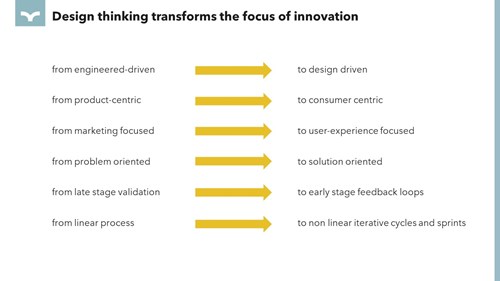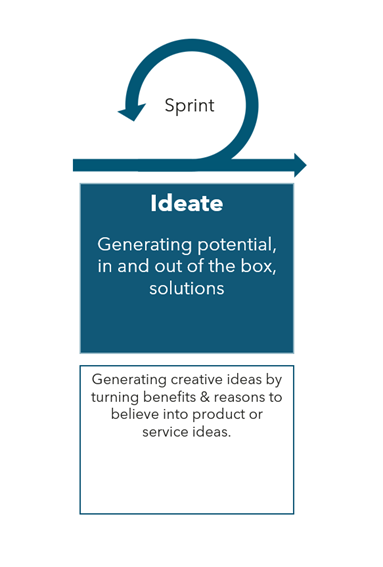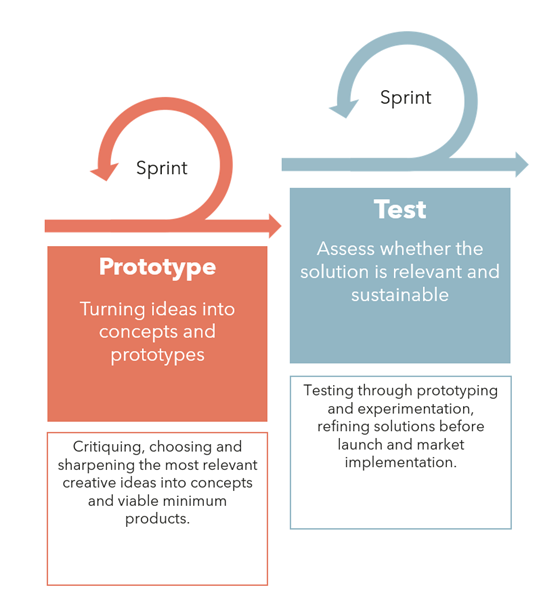Innovation. A ubiquitous word - especially in the business world - that is thrown around without hesitation. Something that even makes some people shudder. But what does it actually mean? It is often described as "the development of new ideas and things" or "the introduction of a new feature". And as many companies experience, there is a tension when it comes to innovation. Because as a company or as a brand, you soon feel the hot breath of others with a similar product or the same services. It is therefore more a matter of outsmarting or outspeeding the others. But how do you do that?
One of the ways to approach innovation is design thinking. It is invariably the strategy we use. Because what makes this method of innovation so strong is that it is done in several steps and - because of the agility of this method - can be adjusted continuously. A small word of explanation:

Innovation along the way
Design thinking shifts the focus of innovations. The focus changes from product to consumer, from marketing to user-experience, from problem to solution, etc. The main idea is to take the market, the consumer and the consumer's needs into account as much as possible at the start of the process. It is a question of continuous testing, instead of validating large projects at certain points in time.
In the entire design thinking process, great importance is attached to consumer feedback. By using fast, short feedback loops with the consumer - the so-called sprints - adjustments are made continuously. In this way, it goes faster, your innovation becomes less expensive, and the innovations have a better chance of success. Better, because very early in the process you listen to the consumer. And by repeating this at regular intervals, you make fewer mistakes afterwards because you are constantly making adjustments. Sometimes it also means going back to the beginning, or having to go to a previous stage now and then, in order to start again from there. So innovation takes shape along the way.
The epicentre of innovation: the consumer
The consumer is always central in the entire innovation process. The consumer is, as it were, the epicentre around which an entire ecosystem is built in order to achieve successful innovation. This success is the result of a consumer centric approach and through blending creativity, logic and the knowledge of all parties involved. Not only by One Inch Whale, but also by the client and by other parties such as creative agencies and (tech) partners, we always keep in mind: "What does the consumer want?". On this collective core message, you develop the product or service. It is no longer created by starting from a pure product marketing strategy where the consumer is invariably bombarded with marketing of your product. No, from now on, you look at what the consumer wants, what he is doing and how we can better support him from there on. On that basis, you adjust your (corporate) communication.
No time to waste: use what you got
Within innovation projects, we always make use of the newest technology. Are there new, good and robust technologies on the market that can be applied? Then that possibility is considered as soon as possible to see if that technology is relevant to the research that will be done. But make no mistake, existing knowledge and data are at least as important. All too often, the knowledge that is already available is ignored. Knowledge that already forms a basis for the innovation or at least can serve as a foundation for it. So don't waste time collecting data that is already available!
Sprinting and switching
In the design thinking process, a number of stages are passed through before the finish line is reached. The motto "What is the purpose of this innovation?" is constantly being shouted from our stands. The consumer and his feedback are of course - without the race already being decided - on the honorary scaffold. Necessary sprints are drawn in the different phases of the process so that feedback is integrated into the race in a short, efficient and fast manner. Moreover, we can switch between the different phases at any time and do not have to stick to a predetermined order.
Our phases of design thinking
Let us look at the phases we use over and over again:
Understanding and defining the ‘problem’
 At the start of the innovation, we want to better understand how everything fits together around the customer's question. We really want to understand what the 'problem' is: the market will be fully explored, the consumer will be identified and we will look at what else is available. We also look at the underlying, hidden needs of the consumer. This is then put into a clear, consumer-centric definition. The 'problem' is reduced to a solution. From there, a pipeline is filled with all kinds of possible, relevant innovations. This is done by using trend analyses, ethnographic deep dives, re-examining existing data and research, social listening, etc.
At the start of the innovation, we want to better understand how everything fits together around the customer's question. We really want to understand what the 'problem' is: the market will be fully explored, the consumer will be identified and we will look at what else is available. We also look at the underlying, hidden needs of the consumer. This is then put into a clear, consumer-centric definition. The 'problem' is reduced to a solution. From there, a pipeline is filled with all kinds of possible, relevant innovations. This is done by using trend analyses, ethnographic deep dives, re-examining existing data and research, social listening, etc.
The phase of ideas

When we fully understand and define the question, we start generating solutions. As many creative ideas as possible are created by transforming the benefits and reasons-to-believe into an idea of a product or service. Regardless of their feasibility, we think of possible solutions that could meet the needs discovered in the previous phases. This creates an extensive list of ideas that are then reduced in a funnel. How? Through creative sessions with internal stakeholders of the client or with consumers.
Convert to concepts/prototypes and test their relevance

Next, it is time to fine-tune the ideas we have created and selected. Here, the most relevant ideas of the product or service are effectively transformed into a concept. In some cases, even into prototypes, to see if the concept has a chance of success. This often leads to new ideas or insights that redefine the problem (phase 2). Of course, when you start working with these prototypes, new problems or new learnings about the consumer will emerge (phase 1).
Depending on the project, different methods can be applied, such as conjoint experiments, concept screeners (to find out which concept has the most potential), observing how consumers interact with certain products or service ideas, checking the user experience, ...
Do you want to stay ahead of your competitors? Then aim for innovations based on the design thinking principle. Many companies and brands compete in a shark-infested red ocean with similar products and services, ignoring the blue ocean around them. It is precisely by using this design thinking method - which we firmly believe in - that you also discover the blue ocean. And with it, you will develop relevant, people-centred innovations and value propositions for long-term success.
Cases of other companies' innovation challenges:
